300 scholarly books by Brandeis University Press and 8
have author last names that start with E
300 scholarly books by Brandeis University Press and 8
300 scholarly books by Brandeis University Press
8 have author last names that start with E have author last names that start with E
8 have author last names that start with E have author last names that start with E
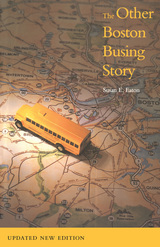
The Other Boston Busing Story
What's Won and Lost Across the Boundary Line
Susan E. Eaton
Brandeis University Press, 2020
METCO, America’s longest-running voluntary school desegregation program, buses black children from Boston’s city neighborhoods to predominantly white suburban schools. In contrast to the infamous violence and rage that greeted forced school busing within the city in the 1970s, the work of METCO has quietly and calmly promoted school integration. But how has this program affected the lives of its graduates? Would they choose to participate if they had it to do over again? Would they place their own children on the bus to suburbia? In The Other Boston Busing Story, sixty-five METCO graduates who are now adults answer those questions and more, vividly recalling their own stories and assessing the benefits and hardships of crossing racial and class lines on their way to school. As courts and policymakers today are forcing the abandonment of desegregation, this book offers an accessible and moving account of a rare program that, despite serious challenges, provides a practical remedy for the persistent inequalities in American education. This new edition puts the original findings in a contemporary context.
[more]
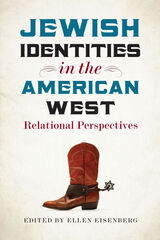
Jewish Identities in the American West
Relational Perspectives
Ellen Eisenberg
Brandeis University Press, 2022
Jewish Identities in the American West fills a significant gap in racial identity scholarship.
Since the onset of New Western History in the 1980s, the complexity of race and ethnicity as it developed in the American West has increasingly been recognized by scholars and the wider public alike. Ethnic studies scholars have developed new perspectives on racial formation in the West that complicate older notions that often relied on binary descriptions, such as Black/white racialization. In the past few decades, these studies have relied on relational approaches that focus on how race is constructed, by both examining interactions with the white dominant group, and by exploring the multiple connections with other racial/ethnic groups in society. Historians are discovering new stories of racial construction, and revising older accounts, to integrate these new perspectives into the formation of racial and ethnic identities. This collection of essays on Jews in the American West advances this field in multiple ways. With essays that cover the period from the mid-nineteenth century to the present, these authors present a collective portrait of change over time that allows us to view the shifting nature of Jewish identity in the West, as well as the evolving frameworks for racial construction. Thorough and thought-provoking, Jewish Identities in the American West takes readers on a journey of racial and ethnic identity in the American West.
Since the onset of New Western History in the 1980s, the complexity of race and ethnicity as it developed in the American West has increasingly been recognized by scholars and the wider public alike. Ethnic studies scholars have developed new perspectives on racial formation in the West that complicate older notions that often relied on binary descriptions, such as Black/white racialization. In the past few decades, these studies have relied on relational approaches that focus on how race is constructed, by both examining interactions with the white dominant group, and by exploring the multiple connections with other racial/ethnic groups in society. Historians are discovering new stories of racial construction, and revising older accounts, to integrate these new perspectives into the formation of racial and ethnic identities. This collection of essays on Jews in the American West advances this field in multiple ways. With essays that cover the period from the mid-nineteenth century to the present, these authors present a collective portrait of change over time that allows us to view the shifting nature of Jewish identity in the West, as well as the evolving frameworks for racial construction. Thorough and thought-provoking, Jewish Identities in the American West takes readers on a journey of racial and ethnic identity in the American West.
[more]
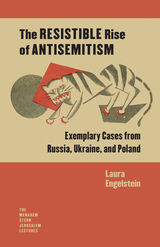
The Resistible Rise of Antisemitism
Exemplary Cases from Russia, Ukraine, and Poland
Laura Engelstein
Brandeis University Press, 2020
Antisemitism emerged toward the end of the nineteenth century as a powerful political movement with broad popular appeal. It promoted a vision of the world in which a closely-knit tribe called “the Jews” conspired to dominate the globe through control of international finance at the highest levels of commerce and money lending in the towns and villages. This tribe at the same time maneuvered to destroy the very capitalist system it was said to control through its devotion to the cause of revolution. It is easy to draw a straight line from this turn-of-the-century paranoid thinking to the murderous delusions of twentieth-century fascism. Yet the line was not straight.
Antisemitism as a political weapon did not stand unchallenged, even in Eastern Europe, where its consequences were particularly dire. In this region, Jewish leaders mobilized across national borders and in alliance with non-Jewish public figures on behalf of Jewish rights and in opposition to anti-Jewish violence. Antisemites were called to account and forced on the defensive. In Imperial and then Soviet Russia, in newly emerging Poland, and in aspiring Ukraine—notorious in the West as antisemitic hotbeds—antisemitism was sometimes a moral and political liability. These intriguing essays explore the reasons why, and they offer lessons from surprising places on how we can continue to fight antisemitism in our times.
Antisemitism as a political weapon did not stand unchallenged, even in Eastern Europe, where its consequences were particularly dire. In this region, Jewish leaders mobilized across national borders and in alliance with non-Jewish public figures on behalf of Jewish rights and in opposition to anti-Jewish violence. Antisemites were called to account and forced on the defensive. In Imperial and then Soviet Russia, in newly emerging Poland, and in aspiring Ukraine—notorious in the West as antisemitic hotbeds—antisemitism was sometimes a moral and political liability. These intriguing essays explore the reasons why, and they offer lessons from surprising places on how we can continue to fight antisemitism in our times.
[more]
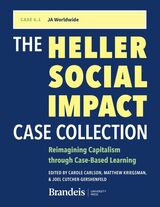
CASE 6.1 JA Worldwide
Creating a Global Brand
Keshia Engwenyi
Brandeis University Press, 2024
This case presents the branding challenge for Junior Achievement (JA) Worldwide, a very large and impactful social impact organization with limiting brand awareness. Reaching over 10 million students in over 100 countries, there is a great story to be told. The case provides students with the opportunity to lean in on a high impact branding challenge.
[more]
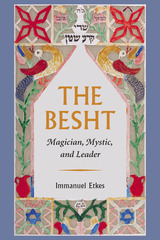
The Besht
Magician, Mystic, and Leader
Immanuel Etkes
Brandeis University Press, 2012
Founded in Eastern Europe in the eighteenth century, the Hasidic movement and its religious thinking have dramatically transformed modern Judaism. The figure of the Ba’al Shem Tov (known in acronym form as the BeSHT)—the purported founder of the Hasidic movement—has fascinated scholars, Jewish philosophers, and laypeople interested in popular Jewish mysticism in general and the contemporary Hasidic movement in all its variety. In this volume, Etkes enters a rich and heated debate over the origins of the movement, as well as the historicity of its mythic founder, Rabbi Israel Ba’al Shem Tov, who lived much of his life as a miracle worker. The eighteenth century, as Etkes vividly portrays, was the heyday of the kabbalists, who dabbled in the magical power of letters and words to solve personal and communal problems—and to earn a living. Etkes sheds light on the personality of the Besht, on his mysticism, and on his close circle of followers. But equally important, he challenges the popular myth of the Besht as a childlike mystic, wandering the fields in prayer, seeing visions and engaging in acts of godliness and piety. Although Etkes shows great empathy for his subject, the Besht who emerges in these pages is much more down to earth, much more a man of his times. Indeed, according to Etkes, it was never the intention of the Besht to found a religious movement. Etkes looks at the Besht’s mystical roots, examining him not only from the vantage point of a social historian, but as a religious figure. Moshe Rosman, author of Founder of Hasidism, a biography of the Besht, claims that In Praise of the Besht—a volume published about the Besht in 1814, many years after his death, which portrayed his character by means of stories told by his close followers—could not be a reliable source. Etkes, disputing this claim, shows definitively that this well-known text (translated and interpreted by, among others, Martin Buber) may indeed offer trustworthy accounts of the Besht’s life and thinking.
[more]
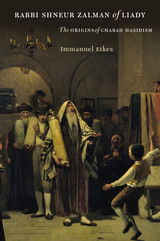
Rabbi Shneur Zalman of Liady
The Origins of Chabad Hasidism
Immanuel Etkes
Brandeis University Press, 2014
Rabbi Shneur Zalman of Liady (1745–1812), in imperial Russia, was the founder and first rebbe of Chabad, a branch of Hasidic Judaism that flourishes to the present day. The Chabad-Lubavitch movement he founded in the region now known as Belarus played, and continues to play, an important part in the modernization processes and postwar revitalization of Orthodox Jewry. Drawing on historical source materials that include Shneur Zalman’s own works and correspondence, as well as documents concerning his imprisonment and interrogation by the Russian authorities, Etkes focuses on Zalman’s performance as a Hasidic leader, his unique personal qualities and achievements, and the role he played in the conflict between Hasidim and its opponents. In addition, Etkes draws a vivid picture of the entire generation that came under Rabbi Shneur Zalman’s influence. This comprehensive biography will appeal to scholars and students of the history of Hasidism, East European Jewry, and Jewish spirituality.
[more]
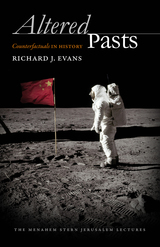
Altered Pasts
Counterfactuals in History
Richard J. Evans
Brandeis University Press, 2014
A bullet misses its target in Sarajevo, a would-be Austrian painter gets into the Viennese academy, Lord Halifax becomes British prime minister in 1940 instead of Churchill: seemingly minor twists of fate on which world-shaking events might have hinged. Alternative history has long been the stuff of parlor games, war-gaming, and science fiction, but over the past few decades it has become a popular stomping ground for serious historians. The historian Richard J. Evans now turns a critical, slightly jaundiced eye on a subject typically the purview of armchair historians. The book’s main concern is examining the intellectual fallout from historical counterfactuals, which the author defines as “alternative versions of the past in which one alteration in the timeline leads to a different outcome from the one we know actually occurred.” What if Britain had stood at the sidelines during the First World War? What if the Wehrmacht had taken Moscow? The author offers an engaging and insightful introduction to the genre, while discussing the reasons for its revival in popularity, the role of historical determinism, and the often hidden agendas of the counterfactual historian. Most important, Evans takes counterfactual history seriously, looking at the insights, pitfalls, and intellectual implications of changing one thread in the weave of history. A wonderful critical introduction to an often-overlooked genre for scholars and casual readers of history alike.
[more]
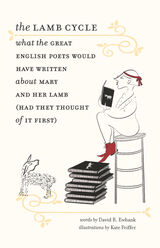
The Lamb Cycle
What the Great English Poets Would Have Written About Mary and Her Lamb (Had They Thought of It First)
David R. Ewbank
Brandeis University Press, 2023
The rhyme “Mary Had a Little Lamb” told in the style—and substance—of the great English poets from Edmund Spenser to Stevie Smith.
In The Lamb Cycle, David R. Ewbank achieves the unthinkable—he writes so convincingly in the style of the great English poets that one could be lulled into thinking that Shakespeare himself was inspired to muse upon the subject of “Mary Had a Little Lamb.” Ewbank captures not only the style of each of the poets he chooses, but also their preoccupations and subject matter. So D.H. Lawrence’s Mary longs for her lamb as any woman longing for her lover, whilst T.S. Eliot’s Mary is recollected by an old man looking back on his life. Alexander Pope writes an “An Essay on Lambs,” and Tennyson’s lotus eaters become “The Clover Eater.” Brilliantly written, sophisticated, and laugh-out-loud funny, these poems, enhanced by Kate Feiffer’s charming illustrations, will enchant anyone who has ever read an English poem.
In The Lamb Cycle, David R. Ewbank achieves the unthinkable—he writes so convincingly in the style of the great English poets that one could be lulled into thinking that Shakespeare himself was inspired to muse upon the subject of “Mary Had a Little Lamb.” Ewbank captures not only the style of each of the poets he chooses, but also their preoccupations and subject matter. So D.H. Lawrence’s Mary longs for her lamb as any woman longing for her lover, whilst T.S. Eliot’s Mary is recollected by an old man looking back on his life. Alexander Pope writes an “An Essay on Lambs,” and Tennyson’s lotus eaters become “The Clover Eater.” Brilliantly written, sophisticated, and laugh-out-loud funny, these poems, enhanced by Kate Feiffer’s charming illustrations, will enchant anyone who has ever read an English poem.
[more]
READERS
Browse our collection.
PUBLISHERS
See BiblioVault's publisher services.
STUDENT SERVICES
Files for college accessibility offices.
UChicago Accessibility Resources
home | accessibility | search | about | contact us
BiblioVault ® 2001 - 2024
The University of Chicago Press









